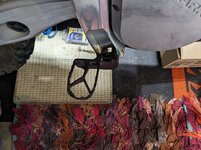FYR
Well-known member
- Likes
- 79
- Location
- Central Valley, CA
There's been some discussion about how the Varg seems to be more difficult to loft the front wheel at will. And, in all honesty, I too find this to be a phenomena related to the Varg, regardless of the mapping/power selections. I don't claim to know much more about that than anyone else, but it could be related to the overall weight or weight bias of the bike.
I did find that my Varg (in stock trim) weighs 271.0 lbs. on my digital pod scales. I use these scales to set up my autocross race cars and they should be very accurate when you consider how much I paid for them (lol), but use this info for reference vs. fact, regardless.
Overall Bike Weight: 271.0 lbs. (note: this is with 2.0mm thick butyl tubes because the original tubes didn't last long enough for me to weigh)
Front Wheel/Rear Wheel Split Weights: Front = 134.6 lbs. , Rear = 136.4 lbs.
Front Wheel Assembly (complete, without axle) = 18.4 lbs.
Rear Wheel Assembly (complete, without axle) = 25.2 lbs.
This all said, I see this as a great opportunity to document complete bike and individual component weights of the Varg. So please, if you guys that have had to replace parts, make warranty swaps, etc., please take a moment to throw your parts on a digital scale and send in your numbers. I will keep a spreadsheet going so we can see where/how our bikes compare and give you credit for your info.
Now, one of my other offroad bikes as compared to my Varg - KTM 250SX (not stock, modified for woods racing):
Overall Bike Weight: 228.1 lbs. (note: this is with Tubliss conversion which weighs more than standard tubes)
Front Wheel/Rear Wheel Split Weights: Front = 110.9 lbs. , Rear = 117.2 lbs.
Front Wheel Assembly (complete, without axle) = TBD
Rear Wheel Assembly (complete, without axle) = TBD
If you just look at the front bias weights of the complete chassis that might give you a hint of why our Vargs feel so front heavy. 23.7 lbs. is just a bit less than a 24 pack of bottled microbrew beer. Not to mention that the weight transfer when trying to loft the front wheel actually rotates around the rear axle. Now image trying to loft your front wheel with a case of Sierra Nevada Pale Ale strapped to your front fender.
I did find that my Varg (in stock trim) weighs 271.0 lbs. on my digital pod scales. I use these scales to set up my autocross race cars and they should be very accurate when you consider how much I paid for them (lol), but use this info for reference vs. fact, regardless.
Overall Bike Weight: 271.0 lbs. (note: this is with 2.0mm thick butyl tubes because the original tubes didn't last long enough for me to weigh)
Front Wheel/Rear Wheel Split Weights: Front = 134.6 lbs. , Rear = 136.4 lbs.
Front Wheel Assembly (complete, without axle) = 18.4 lbs.
Rear Wheel Assembly (complete, without axle) = 25.2 lbs.
This all said, I see this as a great opportunity to document complete bike and individual component weights of the Varg. So please, if you guys that have had to replace parts, make warranty swaps, etc., please take a moment to throw your parts on a digital scale and send in your numbers. I will keep a spreadsheet going so we can see where/how our bikes compare and give you credit for your info.
Now, one of my other offroad bikes as compared to my Varg - KTM 250SX (not stock, modified for woods racing):
Overall Bike Weight: 228.1 lbs. (note: this is with Tubliss conversion which weighs more than standard tubes)
Front Wheel/Rear Wheel Split Weights: Front = 110.9 lbs. , Rear = 117.2 lbs.
Front Wheel Assembly (complete, without axle) = TBD
Rear Wheel Assembly (complete, without axle) = TBD
If you just look at the front bias weights of the complete chassis that might give you a hint of why our Vargs feel so front heavy. 23.7 lbs. is just a bit less than a 24 pack of bottled microbrew beer. Not to mention that the weight transfer when trying to loft the front wheel actually rotates around the rear axle. Now image trying to loft your front wheel with a case of Sierra Nevada Pale Ale strapped to your front fender.

